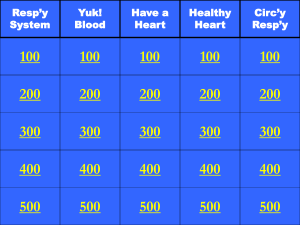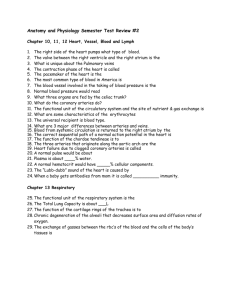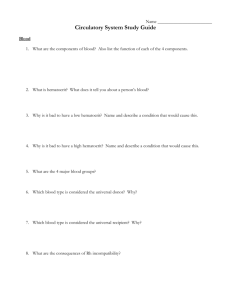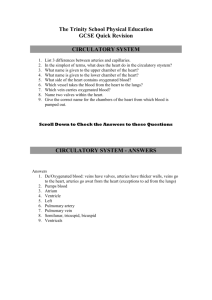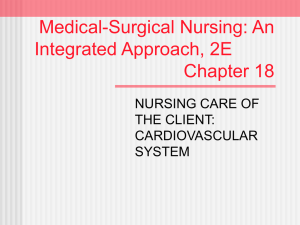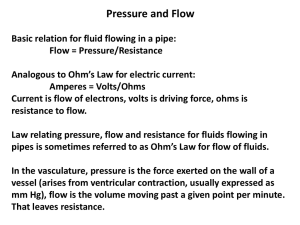Circulatory System
advertisement
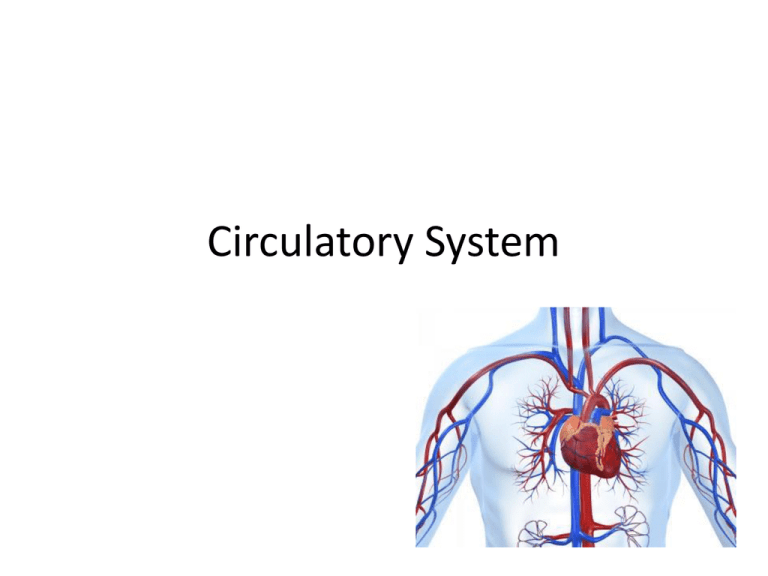
Circulatory System Structures and Functions of the CIRCULATORY SYSTEM 1. Gets Needed substances to cells – carried by blood – oxygen and glucose 2. Picks up waste products from cells – carbon dioxide example: carries Oxygen (O2) to the body and Carbon Dioxide (CO2) away Structures: – Heart – Blood – Blood vessels: • Arteries = carry oxygenated blood AWAY from the heart • Veins = carry deoxygenated blood to the heart • Capillaries = Smallest of all blood vessels. Serves as the connection between veins and arteries. Flow of Blood • • • • • • • • • Start at the heart (right side) Sent to the lungs, where I Pick up oxygen, drop CO 2 Now I turn RED, Then I go back to the heart (left side), where I am Sent to the body Where I drop off oxygen, pick up CO 2 Now I turn Blue… So I go back to the Heart…. Anatomy of the Heart • Pericardium- A fluid filled sac inside the chest cavity that holds the heart. • Myocardium- the muscular middle layer of the heart wall that contains the cardiac muscle tissue. Myocardium makes up the majority of the thickness and mass of the heart wall and is the part of the heart responsible for pumping blood. Below the myocardium is the thin endocardium layer. • Endocardium- the simple squamous endothelium layer that lines the inside of the heart. The endocardium is very smooth and is responsible for keeping blood from sticking to the inside of the heart and forming potentially deadly blood clots. Functions of Blood • Blood is the primary means of transport in the body that is responsible for transporting important nutrients and materials to and from the cells and molecules that make up our body. It is the duty of blood to first take the oxygen processed by the lungs to all the cells of the body • To collect the carbon dioxide from the cells and deliver it to the lungs. It is also tasked with the job of collecting metabolic waste from up and down the body and take it to the kidneys for excretion. • Blood is also a regulator of many factors in the body. It oversees the temperature of the body and maintains it to a level that is tolerated by the body with ease. Blood is also responsible for controlling the concentration of Hydrogen ions in the body, which are also known as pH balance. The administration of the levels of water and salt required by each cell of the body also falls under the regulation duties of blood. Another regulatory task performed by blood is to control the blood pressure and restrict it under a normal range. Functions of Blood • Blood performs the important task of protecting the body from the threat of infections and disease causing bacteria. The white blood cells found in blood are responsible for safeguarding the different organs of the body by producing antibodies and proteins which are capable of fighting off and killing the germs and viruses that can causes serious damage to the body cells. The platelets present in blood handle the task of limiting blood loss in the wake of an injury by helping the blood to clot quickly. Blood Cells The main job assigned to the red blood cells present in the blood is to make sure that the oxygen is delivered to all the cells of the body when the pumping of the blood has been carried out by the heart. The red blood cells have a very quick speed at which they travel through both the veins and arteries. The veins have a relatively smaller wall around them as compared to the arteries since the pressure of the blood is not too intense when it passes through them in comparison to the arteries. Blood Cells The infections that threaten to damage the body are handled by the white blood cells found in blood. White blood cells contain bacterial agents trying to penetrate into the body. These cells which are also known by the name of leukocytes are formed in the stem cells of the bone morrow and start circulating in the body by means of blood as well as the lymph fluid. The whole immune system of a human body is dependent on these white blood cells to identify the pathogens, cells with cancerous material in them and matters which is foreign to the body. In addition to identifying them, leukocytes are also tasked with the duty of destroying and cleaning the body of these enemy cells Cardiac Infarction (Heart Attack) blood flow to a part of your heart is blocked long enough that part of the heart muscle is damaged or dies. Cardiac dysrhythmias Abnormalities of heart rhythm Hypertension (High Blood Pressure) Stroke Blood flow in arteries is too high. (Heart works too hard.) Blood clot in brain that causes brain death




